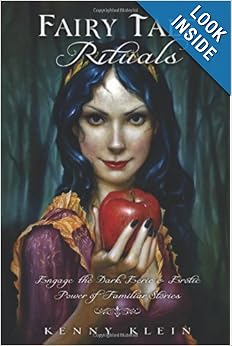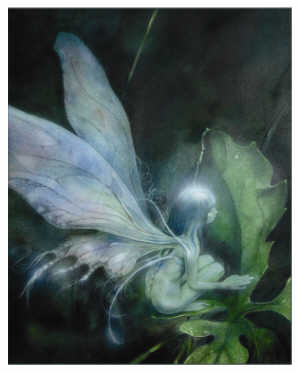I was instantly intrigued by Fairy Tale Rituals: Engage the Dark, Eerie and Erotic Power of Familiar Stories by Kenny Klein. I knew if nothing else it would be an interesting read, and so far that is absolutely true! It's fascinating in one way just because it's a new way of looking at fairy tales for me. Again, I don't agree with everything, but very interesting concepts to ponder.
Klein takes a look at several fairy tales, analyzing the Grimm versions but also looking further back to older tales. He believes that the stories came from beliefs in Faerie creatures-the dark and powerful kind and not the tiny cute kind-which may very well be true in some cases. Many people did used to believe in Faeries, changelings, and all sorts of mischievous Beings that interacted with humans and explained away certain phenomenon.
Klein goes even further, though-providing with each tale a ritual based on Wiccan magic that the reader can practice and perform to enhance change in their own lives. I had to keep reminding myself that he was serious...in my experience, magic spells and wands are things you only find in fiction such as Harry Potter. But although it's something I've never come across in my own life, I know there are a lot of people out there practicing Wicca and other forms of magic. A commenter here once enlightened me that there is even a branch called Faery Wicca. Which I would guess is what this book is all about. Klein says, "As a distant memory of actual Faerie beings, these characters are real, and inhabit this world as we do...so we will evoke these ancient Faerie creatures...for aid in achieving our real-world goals."
"Winged Fairy," Brian Froud
But to think of Snow White as a Faerie with otherwordly beauty actually makes a lot of sense when you think about it. First of all, Klein points out that the Grimms changed Snow White's natural mother to a stepmother, to make it less disturbing. So in the versions where her own mother is trying to kill her, she was also the one who made the wish for a child as red as blood, white as snow, and black as ebony. She therefore is trying to destroy the very child she wished for. So is it just a case of "be careful what you wish for?"
Trina Schart Hyman
Klein goes even further back in Snow White's history to versions where the mother did not wish for a child at all. In one he quotes (with no source,) it is the king who wishes for a child upon three ravens. Snow White is not born to the mother, but just then appears by the side of the road. This story makes a lot more sense as far as imagining why the mother might be so jealous of this strange child's beauty.
I was curious as to how prevalent versions like this were, because this really could change how we view Snow White and her mother/stepmother. I went to my copy of Surlalune's Sleeping Beauties: Sleeping Beauty and Snow White tales from around the world. I only found one story where the father wishes for a child-but actually in the vast majority of them, there is no wishing scene at all-the beautiful child simply exists as the story begins. However, pretty much all the tales were from sources after 1812, when the Grimms' famous version had already been published. I would be very curious to learn if there are more versions like the one Klein referred to, especially ones that predate Grimm.
Margaret Tarrant
Klein also points out how curious it is that absolutely everyone is overwhelmed by Snow White's beauty. She isn't merely beautiful-she motivates a mother to kill, a huntsman to disobey his Queen, dangerous animals to leave her alone, dwarves to protect her, and a prince who absolutely needs to possess her dead body. Not only that, but each of those categories of people would be looking for something different in a female-yet they all find what they most want (or fear) in Snow White. A sexual threat, a homemaker, a ravishing beauty, a lover. It really makes more sense if she is indeed a Faerie or Nymph of unearthly beauty-what else would cause everyone to lose their heads over one woman?
The temptation scene analysis is a striking contrast between Klein and the author I most recently read, Sheldon Cashdan. Cashdan believed that fairy tales help children overcome their sinful tendencies through 1. identifying their sins in the sins of the main character, and 2. also identifying with the villain. I simply don't think that happens in the vast majority of cases. Anyway, to Cashdan, when Snow White accepts gifts from her stepmother in disguise, it's proof that she suffers from the sin of vanity.
Trina Schart Hyman
Klein sees the scene as the stepmother/mother trying to undo Snow White's beauty. By putting the laces on Snow White, the witch is "tightly binding the Nymph's breasts." Only...don't stay laces tighten your waist but support the breasts in a way that makes them look larger, much like a corset? Like above?
But anyway other than that fact he does have a very interesting point. The three objects the mother uses-laces, a comb, and the apple-are attempts to destroy the three parts of the mother's wish: skin as white as snow (the laces which bind the skin), hair as black as ebony (the poisoned comb) and lips as red as blood (the apple).
Then the sleep episode. This is where feminists of today are outraged, because to have famous fairy tale princesses sleeping indicates that men want their women passive. It was kind of refreshing to hear a different take. Klein says, "While we appear to be dead in sleep, our minds are quite active, connecting us to the Underworld through dreams." He says Snow White goes through a near death experience which enables her to become fully human and later accept a lover. He cites many world religions which involve a ritual that is symbolic of death and rebirth-from pagan beliefs to Christian baptism (although, some of the things he says about biblical passages and/or the Christian faith are incorrect, which makes me wonder how accurate some of his other facts are).
Anyway, it's an interesting thought, and encouraging to think that maybe Snow White (and Sleeping Beauty) are being anything but passive in their sleep. In fact, Klein also points out that the Beast, a MALE fairy tale character, has a similar unconscious/sleep phase-can't believe I hadn't thought of that before. And though, in the Villeneuve version, the sleep is not directly connected to his transformation, in most other versions it's after Beauty revives the Beast from his near death that he has his rebirth into humanity. Hmm...
Then follows an actual Wiccan-inspired ritual detailed for the reader to follow. It involves calling the spirit of Snow White to make you feel beautiful and desirable, and the cutting of an apple, on the New Moon, and an alter and a wand and all that. I kept thinking of Willow from Buffy...
*Also-this post from Ravens Shire/Fairies and Fairy Tales is on the remnants fairy tales have from ancient religions, and is very applicable to the above








Oh wow. I've been aware of this book for a while but hadn't picked it up because I thought it would be mainly ritual rather than analysis/speculation. Much of this jives well with the way Snow White speaks to me to: the body, mind, spirit triad can be seen here, the nature empowered Snow White (which at the time was seen as something unnatural, to be feared - still is in many ways) and more. (I actually have a folder full of notes and story snippets on developing an idea of Snow White like this - far more primal and nature-empowered, which gives a different light to everyone's reaction to her, and gives her a more long-term view/plan of her own. Unlikely this will ever see the light of day but it's still fascinating to me.)
ReplyDeleteI hadn't completely connected the undoing of a wishing spell though in the lips/blood, hair/ebony, skin/snow being "undone" with the triple visit/spelled objects though.
This is one of the reasons I love Snow White - there are so many ways to look at this tale. Her being a passive princess is only one of them, and was never how I saw her. (I knew very early on, maybe age 5 or 6, that Grimm's Little Snow White was only 7, so being my age at the time, I found her extremely brave and optimistic in the face of horrific things.)
This is quite a fascinating idea too - the idea of a nymph/beautiful changeling. (I have to admit, I too never think of changelings as being ultra-beautiful - usually deformed or not of a 'normal' human character etc Are there sources/references quoted for the "common story of the beautiful changeling"? I'd be interested to read some.) but yes, this WOULD make for a huge motivation. I hadn't thought of all the aspects of what people desire from females being found in one woman either. The sleep idea isn't new to me but I hadn't considered the Beast having one of his own either.
Thanks Kristin! I'm curious about the other tales in the book as well now. I might have to pick up a copy of this...
What I wouldn't give to see your folder of story ideas!!
ReplyDeleteAnd yeah it was a really refreshing read, just to have all these new ideas. But no, he didn't cite any of the beautiful changeling stories. He also seems to blend together a lot of supernatural creatures-he calls Snow White an urchin, changeling, and Nymph, and I'm pretty sure those are all distinct things...My main criticism of the book overall would be that element of doubt about his research. But still well worth it for his unique perspective!